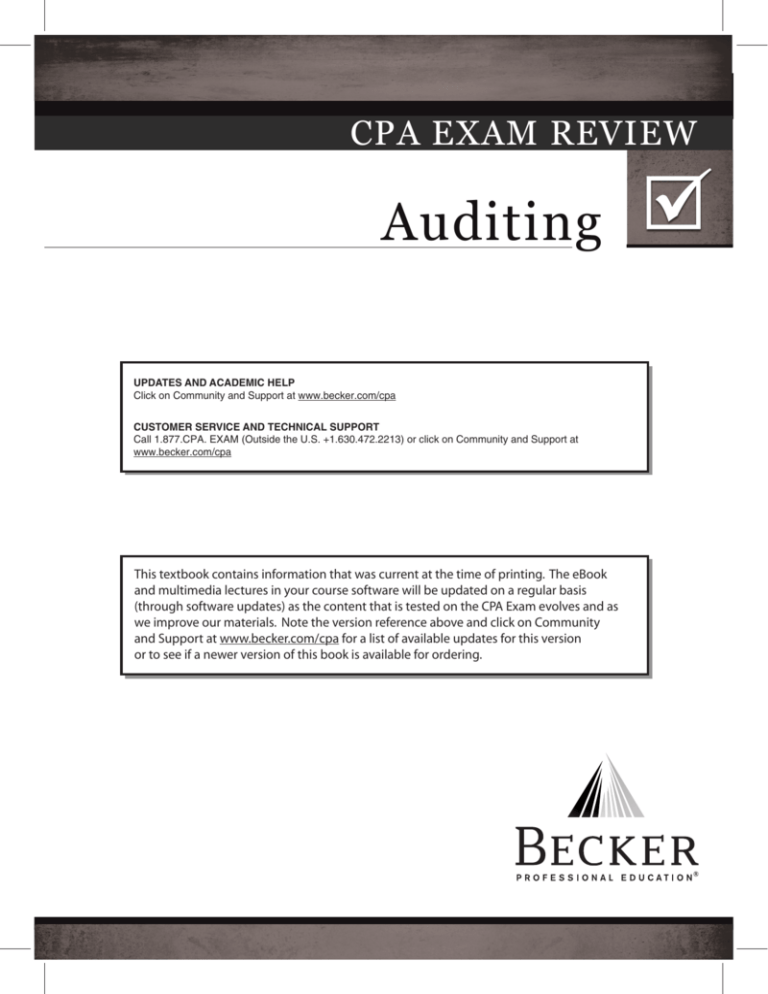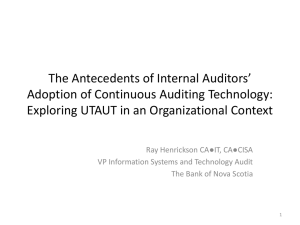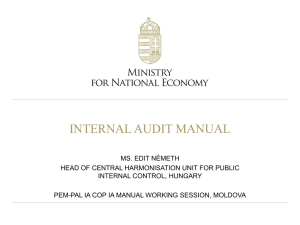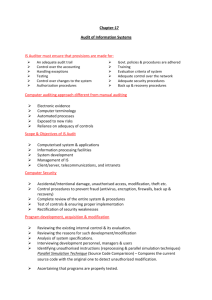
V 1.0
CPA EXAM REVIEW
Auditing
UPDATES AND ACADEMIC HELP
Click on Community and Support at www.becker.com/cpa
CUSTOMER SERVICE AND TECHNICAL SUPPORT
Call 1.877.CPA. EXAM (Outside the U.S. +1.630.472.2213) or click on Community and Support at
www.becker.com/cpa
This textbook contains information that was current at the time of printing. The eBook
and multimedia lectures in your course software will be updated on a regular basis
(through software updates) as the content that is tested on the CPA Exam evolves and as
we improve our materials. Note the version reference above and click on Community
and Support at www.becker.com/cpa for a list of available updates for this version
or to see if a newer version of this book is available for ordering.
Auditing
Becker Professional Education | CPA Exam Review
AUDITING
table of contents
Program attendance record............................................................................................................................................................... v
Introduction................................................................................................................................................................................. Intro-1
AUDITING 1: Audit Reports
1. Audited financial statements: The basics................................................................................................................................ A1-3
2. Professional standards............................................................................................................................................................. A1-6
3. Reports on audited financial statements............................................................................................................................... A1-12
4. Reports on comparative financial statements....................................................................................................................... A1-45
5. Events occurring after year-end............................................................................................................................................. A1-52
6. Reporting on other information............................................................................................................................................ A1-57
7. Appendix: The PCAOB auditor's reporting model.................................................................................................................. A1-67
8. Class questions...................................................................................................................................................................... A1-69
aUDITING 2: Other Reports
1. Other engagements, reports, and accounting services........................................................................................................... A2-3
2. Compilation and review of financial statements................................................................................................................... A2-24
3. Reporting on comparative financial statements.................................................................................................................... A2-53
4. Review of interim financial information................................................................................................................................ A2-57
5. Letters for underwriters......................................................................................................................................................... A2-69
6. Attest engagements............................................................................................................................................................... A2-71
7. Class questions...................................................................................................................................................................... A2-91
Auditing 3: Engagement Acceptance, Planning, and Risk Assessment
1. Engagement acceptance and understanding the assignment................................................................................................. A3-3
2. Planning and supervision....................................................................................................................................................... A3-10
3. Audit risk................................................................................................................................................................................ A3-25
4. Fraud risk............................................................................................................................................................................... A3-29
5. Compliance with laws and regulations.................................................................................................................................. A3-37
6. Assessing the risks of material misstatement........................................................................................................................ A3-40
7. Internal control...................................................................................................................................................................... A3-48
8. Responding to the assessed risks of material misstatement................................................................................................. A3-66
9. Class questions...................................................................................................................................................................... A3-77
© DeVry/Becker Educational Development Corp. All rights reserved.
vii
Auditing
Becker Professional Education | CPA Exam Review
Auditing 4: Audit Evidence
1. Audit evidence......................................................................................................................................................................... A4-3
2. Audit procedures by transaction cycle................................................................................................................................... A4-19
3. Other audit procedures......................................................................................................................................................... A4-50
4. Evaluating audit findings........................................................................................................................................................ A4-58
5. Appendix I: Financial ratios.................................................................................................................................................... A4-64
6. Appendix II: Control procedures and tests of controls.......................................................................................................... A4-75
7. Class questions...................................................................................................................................................................... A4-79
Auditing 5: Sampling and Communications
1. Audit sampling......................................................................................................................................................................... A5-3
2. Internal control communications........................................................................................................................................... A5-22
3. Communication with those charged with governance.......................................................................................................... A5-50
4. Management representations............................................................................................................................................... A5-56
5. Class questions...................................................................................................................................................................... A5-61
Auditing 6: Professional Responsibilities, Audit Documentation, Effect of IT, Government Auditing, and Quality Control Standards
1. Professional responsibilities.................................................................................................................................................... A6-3
2. Audit documentation............................................................................................................................................................. A6-31
3. The effect of information technology on the audit............................................................................................................... A6-35
4. Government auditing............................................................................................................................................................. A6-41
5. Quality control standards...................................................................................................................................................... A6-65
6. Class questions...................................................................................................................................................................... A6-75
Class question explanations.......................................................................................................................................................... CQ-1
Glossary................................................................................................................................................................................... Glossary-1
Index........................................................................................................................................................................................... Index-1
viii
© DeVry/Becker Educational Development Corp. All rights reserved.
Auditing 1
Audit Reports
1. Audited financial statements: The basics.................................................................................................................................... 3
2. Professional standards................................................................................................................................................................. 6
3. Reports on audited financial statements................................................................................................................................... 12
4. Reports on comparative financial statements........................................................................................................................... 45
5. Events occurring after year-end................................................................................................................................................. 52
6. Reporting on other information................................................................................................................................................ 57
7. Appendix: The PCAOB auditor's reporting model...................................................................................................................... 67
8. Class questions.......................................................................................................................................................................... 69
Auditing 1
Becker Professional Education | CPA Exam Review
A u d i t e d f i n a n c i a l s tat e m e n t s
T h e B a s i c s
I.
The Independent Audit FUNction
A.
The Purpose of an Audit
The purpose of an audit is to provide financial statement users with an opinion on whether
the financial statements are presented fairly, in all material respects, in accordance with the
applicable financial reporting framework.
Pa s s K e y
The applicable financial reporting framework is the financial reporting framework that is acceptable in view of
the nature of the entity and the objective of the financial statements, or that is required by law or regulation.
Acceptable financial reporting frameworks include general purpose frameworks designed to meet the needs
of a wide range of users (e.g., U.S. GAAP and International Financial Reporting Standards [IFRSs]), and special
purpose frameworks (discussed in lecture A-2).
U. S . A u d i t i n g S ta n d a r d s v s . I n t e r n at i o n a l S ta n d a r d s o n A u d i t i n g
ISAs discuss both compliance frameworks and fair presentation frameworks when discussing applicable financial
reporting frameworks. U.S. GAAS does not make any reference to compliance frameworks because all financial
reporting frameworks used in the United States are fair presentation frameworks. A fair presentation framework
is a financial reporting framework that requires compliance with the requirements of the framework and:
– acknowledges explicitly or implicitly that to achieve fair presentation of the financial statements, it may be
necessary for management to provide disclosures beyond those specifically required by the framework; and
– acknowledges explicitly that it may be necessary for management, in extremely rare circumstances, to depart
from a requirement of the framework to achieve fair presentation of the financial statements.
B.
Audit Function Adds "Credibility"
The auditor's report gives credibility to the financial statements. The auditors, as a group
independent of management, have an objective view and can report on a company's
activities without bias or conflict of interest. Without a report from an independent auditor, a
company's financial statements would be meaningless, because the public would have little
faith in financial statements issued by the inherently biased company.
C.Responsibilities
The financial statements of an enterprise are prepared by the management of the enterprise,
not by the independent auditor. Further, the financial statements are the product and property
of the enterprise; the independent auditor merely audits and expresses an opinion on them.
1.
Management Responsibilities
An audit is conducted on the premise that management and, when appropriate, those
charged with governance, are responsible for:
a.the preparation and fair presentation of the financial statements in accordance with
the applicable financial reporting framework;
© DeVry/Becker Educational Development Corp. All rights reserved.
A1-3
Auditing 1
Becker Professional Education| CPA Exam Review
b.
the design, implementation, and maintenance of internal control relevant to the
preparation and fair presentation of financial statements that are free of material
misstatement due to error or fraud; and
c.
providing the auditor with access to information and persons within the entity
needed to complete the audit.
Pa s s K e y
The preparation and fair presentation of the financial statements requires:
1. identification of the applicable financial reporting framework;
2. preparation and fair presentation of the financial statements in accordance with the framework; and
3. inclusion of an adequate description of the framework in the financial statements.
2.
Auditor Responsibilities
The auditor is responsible for expressing an opinion on the financial statements based
on the audit. The auditor is also responsible for having appropriate competence
and capabilities to perform the audit, complying with relevant ethical requirements,
maintaining professional skepticism, and exercising professional judgment throughout the
planning and performance of the audit.
D.Performance
In order to express an opinion, the auditor obtains reasonable assurance about whether the
financial statements are free from material misstatement, whether due to error or fraud.
1.
Reasonable Assurance
Reasonable assurance is a high, but not absolute, level of assurance. In order to
obtain reasonable assurance, the auditor must:
2.
a.
plan the work and properly supervise any assistants;
b.
determine and apply appropriate materiality levels;
c.
identify and assess risks of material misstatement, whether due to fraud or error; and
d.
obtain sufficient appropriate audit evidence.
Inherent Limitations of an Audit
The auditor is unable to obtain absolute assurance that the financial statements are
free from material misstatement because of the following inherent limitations:
a.
The Nature of Financial Reporting
Some financial statement items are subject to an inherent level of variability
because they involve judgment by management or because they involve subjective
decisions or assessments or a degree of uncertainty (e.g., accounting estimates).
b.
The Nature of Audit Procedures
There are practical and legal limits on an auditor's ability to obtain audit
evidence, including:
(1) The possibility that management or others may not provide, intentionally or
unintentionally, the complete information that is needed for the preparation and
presentation of the financial statements or that is requested by the auditor.
(2) Fraud may be concealed in such a way that it is difficult to detect with audit
procedures.
A1-4
© DeVry/Becker Educational Development Corp. All rights reserved.
Becker Professional Education | CPA Exam Review
Auditing 1
(3) An audit is neither an investigation into a wrongdoing nor does the auditor
have specific legal powers.
c.
Timeliness of Financial Reporting and the Balance Between Cost and Benefit
There is an expectation by users of financial statements that the auditor will form
an opinion on the financial statements within a reasonable period of time and will
achieve a balance between benefit and cost, recognizing that it is impracticable to
address all information that may exist. Therefore, it is necessary for the auditor to:
(1) plan the audit so that it is performed effectively;
(2) direct efforts to areas most expected to contain risks of material
misstatement; and
(3) use testing and other means of examining populations for misstatement.
© DeVry/Becker Educational Development Corp. All rights reserved.
A1-5
Auditing 1
Becker Professional Education| CPA Exam Review
P r o f e s s i o n a l s ta n d a r d s
I.
Auditing Standards
A.
Generally Accepted Auditing Standards
The auditor is responsible for the performance of a properly planned and executed audit in
accordance with generally accepted auditing standards (GAAS). Note that compliance with
GAAS is mandatory on all audit engagements.
SAS
Generally accepted auditing standards for the audits of nonissuers are issued by the AICPA's
Auditing Standards Board (ASB) in the form of Statements on Auditing Standards (SAS).
The ASB's Statements on Auditing Standards are outlined in Section AU of the AICPA
Professional Standards.
Pa s s K e y
To address concerns about the clarity, length, and complexity of its standards, and to converge its standards
with the International Standards on Auditing (ISAs), the ASB redrafted all of its SASs. These clarified SASs were
issued by the ASB in late 2011 and are effective for audits of financial statements for periods ending on or after
December 15, 2012. The clarified SASs are outlined in Section AU-C of the AICPA Professional Standards, to
avoid confusion with the existing AU sections, which remain effective through 2013. The AU-C identifier will
revert to AU in 2014. These Becker audit materials are based on the clarified SAS, which are testable on the
CPA Exam starting on July 1, 2013.
B.
GAGAS
C.
PCAOB
Generally Accepted Government Auditing Standards
Audits of government organizations, programs, activities, and of entities that receive
government funds should be conducted in accordance with generally accepted government
auditing standards (GAGAS), as covered later in the course.
Public Company Accounting Oversight Board
The Public Company Accounting Oversight Board (PCAOB) was established pursuant to the
Sarbanes-Oxley Act of 2002. The PCAOB establishes auditing and related professional
practice standards to be used in the preparation and issuance of audit reports for issuers.
1.
Issuers consist of entities subject to the rules of the SEC (primarily public companies).
2.
The PCAOB is comprised of five full-time, financially literate members.
3.
A1-6
a.
Two members must be (or have been) CPAs, and the other three must not be (or
must not have been) CPAs.
b.
A CPA can only act as the Chair of the Board if he or she has not practiced as a
CPA for the past five years.
c.
No members of the Board can receive payments from a public accounting firm
(other than fixed continuing payments, such as retirement payments).
Public accounting firms must register with the PCAOB in order to audit a public
company. Registered firms are subject to Board inspection, disciplinary proceedings,
and sanctions.
© DeVry/Becker Educational Development Corp. All rights reserved.
Becker Professional Education | CPA Exam Review
4.
Auditing 1
PCAOB Auditing Standards (AS)
a.
AS
The PCAOB adopted, on an initial, interim basis, ASB standards, but continues to
review each standard to evaluate whether it should be modified, repealed, replaced,
or permanently adopted. The PCAOB has issued several of its own Auditing
Standards (AS), which replace ASB Standards for audits of issuers. These
Auditing Standards will be covered throughout the course.
Be sure to visit the Becker website for possible updates to this area.
b.
D.
Note that the ASB retains the authority to set performance and reporting
standards for audits of financial statements of nonissuers.
International Standards on Auditing
ISA
The International Auditing and Assurance Standards Board (IAASB), a standard setting board
of the International Federation of Accountants (IFAC), establishes International Standards on
Auditing (ISA). The IFAC is a worldwide organization that establishes and promotes
adherence to high-quality professional standards and works toward the international
convergence of such standards. ISAs issued by the IAASB do not override the local laws
and regulations or national standards that govern the audits of historical financial statements
in particular countries. Over 100 countries are using or are in the process of adopting or
incorporating the ISAs into their national auditing standards or are using the ISAs as a basis
for preparing national auditing standards.
II.
Standards for Engagements Other than Audits
An audit is merely one type of engagement an accountant may be called upon to perform. Each
type of engagement has a different set of applicable professional standards, and the requirements,
responsibilities, and limitations vary with the nature and scope of the engagement. Below is an
overview of standards for engagements other than audits that will be tested on the Auditing and
Attestation section of the CPA exam.
A.
Statements on Standards for Attestation Engagements
SSAE
Statements on Standards for Attestation Engagements (SSAE) are issued by the AICPA.
These standards apply to attest engagements, covered later in the course. The SSAEs are
outlined in Section AT of the AICPA Professional Standards.
B.
Statements on Standards for Accounting and Review Services
SSARS
The Accounting and Review Services Committee was established by the AICPA to establish
standards for privately-held (nonissuer) companies not seeking audited statements.
Statements on Standards for Accounting and Review Services (SSARS) are issued by this
Committee, and they are applicable to unaudited financial statements or unaudited financial
information of a nonpublic entity. SSARS are covered later in the course. The SSARS are
outlined in Section AR of the AICPA Professional Standards.
© DeVry/Becker Educational Development Corp. All rights reserved.
A1-7








